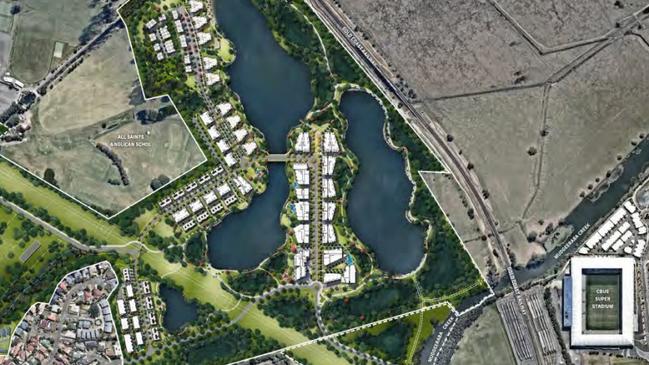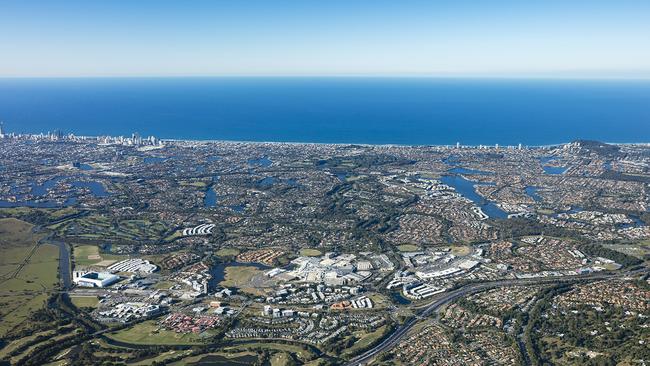Meaghan Scanlon uses new planning powers to fast track Robina estate on floodplain
A $1.2 billion residential estate planned on a Gold Coast floodplain will be almost doubled in size after a stunning intervention by the State Government.
Gold Coast
Don't miss out on the headlines from Gold Coast. Followed categories will be added to My News.
A $1.2 billion residential estate planned on a Gold Coast floodplain will be almost doubled in size, after a stunning intervention by the State Government to fast forward more low cost housing.
Housing Minister Meaghan Scanlon has given the green light for the Breakwater project at Robina to be a much bigger development, sparking strong opposition from City planning chair Mark Hammel and area councillor Dan Doran.
Both councillors are urging Ms Scanlon “to reconsider” given concerns about flooding and impacts on the congested road network in a suburb confronted with peak hour gridlock.
But Ms Scanlon told the Bulletin: “Remove the barriers, speed up approvals and you’ll fuel housing construction – that’s what industry told us, so that’s what we did.”
The Housing Minister and Gaven MP, for the first time in city planning, used the new State Facilitated Development (SFD) pathway for the site just north west of Cbus Stadium.
The council in 2021, concerned about four lakes being created for a 73ha master planned community where buildings would be on platforms, approved only 1500 dwellings.

The Government has increased this to 2750 dwellings with 15 per cent to be “affordable”.
Mr Hammel said the only communication from Ms Scanlon to City CEO Tim Baker was a letter saying the SFD would be used — raising concerns about lack of detail.
Ms Scanlon said she had spoken to Mayor Tom Tate and “talked him through the process”.
She was surprised by Mr Hammel’s opposition given council had given “preliminary approval” to the project and the Government was following that process.
“It has to be on three building pads they’ve approved. It takes into account flood mitigation,” she said.
Both Mr Hammel and Ms Scanlon clashed recently after her decision to intervene, using a rare planning power, to approve hundreds of new homes at the abandoned Arundel Hills Country Club site. Council had earlier backed residents and rejected a developer application.
“I absolutely understand the need for more dwellings in this city – it is critical. However, just as critical is supplying the infrastructure to support these dwellings,” Cr Hammel said.
“We are a city that wants to work with the State Government and the development industry to
create more dwellings – but this isn’t the way to do it.”
The SFD process was a brand-new development pathway available to developers that bypasses local government, Mr Hammel said.
“The City was not aware this had even been considered for this site until receiving a letter from the Minister,” he said.
“We were provided a three-page letter with a map and asked to provide a submission… without any additional information – how can a local government be asked to provide a submission?
“There were no updated plans, no updated infrastructure network capacity assessments, no
updated design brief – no information was provided to the City that we can actually respond to.
“This is a significant site in a challenging development location – it has major hydraulic constraints and major infrastructure network capacity constraints, especially around road and sewerage capabilities.”

The original council approval in 2021 followed a “an extremely thorough assessment process” where planners decided the maximum number of dwellings should be 1500.
“To have now almost doubled that number without providing the planning work to support the
increase raises some serious questions about the site,” Mr Hammel said.
“We don’t know the new proposed heights of buildings, density, layout or any planning information about the surrounding network.
“In our response to the Minister we have raised concerns about possible severe impacts to the local road network, sewerage network and potential hydraulic impacts to neighbouring sites.”
Mr Doran said Robina could accept more density but it needs to be done in a considered manner with a local growth management strategy.
“Our road network is at capacity, the Robina Hospital is at breaking point, the Robina State High School is at 94 per cent capacity, Robina Police Station hasn’t grown in 20 years and they’ve recently removed the Police Beat from the town centre.

“This is a poor planning decision that will have terrible effects on my community for a decade or more.
“Changing this carefully considered approval to the benefit of a developer’s bottom line, and for a campaign press release, is irresponsible and the very definition of poor governance. I urge the Minister to reconsider.”
Ms Scanlon, the Gaven MP, in her letter to Mr Baker said the SFD was a key part of the Government’s $3.1 billion Homes for Queenslanders plan.

“Streamlined approval pathways have been specifically identified as a measure that each state must bring forward under the National Planning Reform Blueprint,” she said.
“State Facilitated Development provides a pathway to faster decisions and resolution of planning and infrastructure issues to provide housing, including social and affordable homes.”
Ms Scanlon said she was “pleased to advise that I have commenced the process”.
“Given the site’s location and proximity to existing services and infrastructure, it has potential to provide more homes and is considered under-utilised in its current form,” she said.
She said the City could make representations on the site’s suitability for State Facilitated Development.
Ms Scanlon on Sunday announced the Walker Group’s build-to-sell proposal for Robina, alongside a 45-home project at Wakerley in Brisbane.
The declared projects at Robina and Wakerley are among 12 sites currently being considered for pilot projects under the SFD pathway.

“The first two projects include a very significant development on the Gold Coast and a project on faith-based land at Wakerley,” she said.
“If all declared, the pilot projects alone will unlock more than 4945 homes in places that are well-located to the transport, schools, jobs and services that people need.
“This process isn’t a free pass, though. Buildings are required to be substantially underway within two years.
“I’m about more housing so my generation can afford to get into the market and that means moving faster.”
More Coverage
Originally published as Meaghan Scanlon uses new planning powers to fast track Robina estate on floodplain





